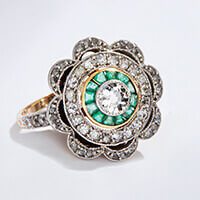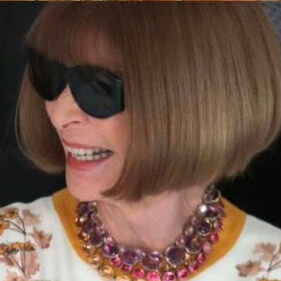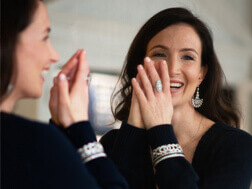-
Your Shopping Bag is empty
Deeds, Words and Suffragette Jewellery
‘Deeds not words’ was the maxim of the Suffragette. In 1903, feminist icon Emmeline Pankhurst founded the WSPU (Women’s Social and Political Union). Its prime motive: to secure equal voting rights for women. The group sparked controversy for its increasingly ‘unladylike’ methods that left words behind in favour of assertive action.
At first rooted in letter writing debate and petition, the movement began to employ bombastic methods at Pankhurst’s command. After a spate of window smashing on Oxford Street, The Daily Mail coined the name ‘Suffragette’ in 1906, seeking to mock the women’s ‘imitation’ of militancy. This caused a divide in the women’s movement. Violence did not square well with the Edwardian ideals of womanhood – ideals which many women, though keen for political agency, wished to adhere to. The militancy of Pankhurst and her brigade struggled to win over the mild mannered women of Edwardian Britain.
In the analysis of the material culture of Suffragism, it is clear the movement took a visual approach to courting the interests of upper-class women. Perhaps in their case, the answer lies not in deeds, nor words, but in jewellery.
Suffragette Spending Power
Seldom analysed is the sheer market power of suffragism as a fashionable aesthetic. The history books, though littered with Lady this and Lady that, underestimate the considerable weight of spending power by what was largely an upper class movement.
Furthermore, suffrage’s relationship with educated creatives (chiefly amongst the Arts and Crafts movement) reveals a rich legacy of material creation and marketable design, all of which bolstered the visual identity of the suffragettes as a respectable and legitimate movement.
Jewellery – a recognised facet of acceptable womanly beauty – was cunningly appropriated to become a symbol of feminine allegiance and political valour. From honorary rewards, to mass-made commercial pieces, to featuring in political portraiture, the jewellery of the day shows a side to the movement that relied upon the power of aesthetics.
What is Suffragette Jewellery?
Historians and antiquarians alike have found it puzzling to define exactly what suffragette jewellery was. Whilst the colour combination of purple, white and green were deeply intertwined with the movement, they argue that these colours gradually became so absorbed into general Edwardian fashion, that many wore them without even knowing they were representative of the suffragette cause.
Perhaps this indicates the success of the suffragette visual identity. It was popular, marketable and wearable and therefore became widely fashionable. However, it is simply implausible that people would dissociate purple, white and green with the Suffragette movement pre-WWI. It was ‘big news’ and controversial. The colours, a sign of allegiance, would more often than not, evoke a response from onlookers. Whether that was positive, or decidedly more often ‘violently antagonistic’. It is more likely that antiquarians are unwilling to admit the sheer market success of a women’s political movement.
To complicate matters further, scholars cannot seem to decide whether suffragette jewellery encompassed both decorative designs as well and medallic forms (‘medallic’ meaning pieces honorarily bestowed upon deserving suffragettes for their service). To make life easier, we define suffragette jewellery as jewellery made and worn in the 7 years immediately preceding the outbreak of WW1 and during it, using motifs associated with suffrage including, but not restricted to, the colours purple, white and green in both decorative, and medallic forms.
The Tricolor Brand
The true importance of the purple, white and green colour combination was its symbolism and sheer marketability. Designed by Mrs Pethwick Lawrence in 1908, she described it in a Spring issue of Votes for Women as follows:
Purple is the royal colour … It stands for the royal blood that flows in the veins of every suffragette, the instinct of freedom and dignity … White stands for purity in private and public life … Green is the colour of hope and the emblem of spring
Robust ideology and strongly recognisable aesthetic language branded suffragism, shaping it as a distinct and desirable identity (particularly, impressive in an age of black and white photography).
It was assertively marketed by leading suffragettes, spurred on by Mrs Lawrence’s ambitions to make the colours the ‘reigning fashion’ which would be achieved if every suffragette ‘would do her part’ in donning the trio.
Cleverly turning fashion into duty, the suffragette movement appropriated traditional aspects of womanhood and politicised them. Evidence of the success of the ‘fashion campaign’ can be seen in the number of dedicated suffragette bazaars as well as participating shops such as Debenham and Freebody, Liberty & Co, Peter Robinson, Jaeger, Derry and Toms, Lilley and Skinner and The London Shoe Company – many of which remain household names.
Parallels to Today
One wonders to what extent large businesses of the time saw commercial viability in aligning themselves with a popular, and potentially lucrative, political movement. Or perhaps sacrificing a page in a catalogue was better than a brick through the window. It is almost reminiscent of Oxford Street during Pride month (June) where instead of purple, white and green, high streets are decorated by the rainbow and selling all sorts of rainbow paraphernalia. How helpful this is to the cause is, of course, the subject of heated debate.
One also wonders whether there was a certain cultural pressure to align oneself with suffragism as it commercialised itself. Take for example the trend of appearing ‘woke’ today. Whilst many do live and breathe to challenge the system, others employ the language, fashion and ‘vibe’ of wokism to achieve clout on social media platforms. It is worth consideration, but perhaps not a perfect comparison.
Shopping for Suffragettes
By the end of 1911 the WSPU had 36 branches in London alone, 10 of them with shops attached and 86 branches with 17 shops in the rest of the country. If this doesn’t speak to the importance suffragettes placed on image, both its foot soldiers and commanders, one doesn’t know what does. There was even a mail order service if one didn’t want to be seen at the shops… or indeed if one couldn’t be bothered.
A budding suffragette was able to procure an enormous range of merchandise including suffragette soap, cakes iced in the colours, chocolate, marmalade, tea and coffee packed in the colours, china tea sets decorated with the WSPU symbol, and even bicycles enamelled in green with purple and white lines. But most popularly, jewellery.
A Mappin & Webb catalogue for Christmas 1908 features a page dedicated to “Suffragette Jewellery,” including five pieces “in enamel and gems” – brooches and pendants set in gold with emeralds, pearls, and amethysts and costing between 2 and 6 pounds. For comparative purposes, a kitchen maid in England at that time could earn as little as 8 pounds a year.
Whilst these prices ran high, during this period jewellery was slowly becoming increasingly available to the masses due to industrialisation. Much more sensitive to the working woman’s wage, a Liberty & Co catalogue featured a small bow pendant at only 1 penny.
Rapidly, the growing efficacy of mechanised systems facilitated a boom in the production of Suffragette jewellery. Laden with purple gems like Amethysts, Garnets, Lepidolites and Tanzanites; Green gems like Emeralds, Peridots, Serpentine, and Chrysophase and; White gems like Pearls, Moonstones, Opals, Clear Quartz and Diamonds – Suffragette jewellery adapted to fit any price range.
Keeping those women who sought to maintain some sense of Edwardian womanhood, their design took the highly feminised forms of bows, floral motifs, stars, clovers, garlands, filigrees and hearts. Such feminine forms added to the subterfuge that these women were adopting, making them appear elegant, genteel and possessing grace and refinement; women that were clearly educated, from wealthy families and who were keen to be respected despite the controversy of their views.
Leaning into masculinity
Whilst suffragette jewellery adopted feminine forms, it also co-opted masculine military designs. One of the most authentic pieces of suffragette jewellery is a Holloway Brooch, which eschewed traditional feminine motifs.
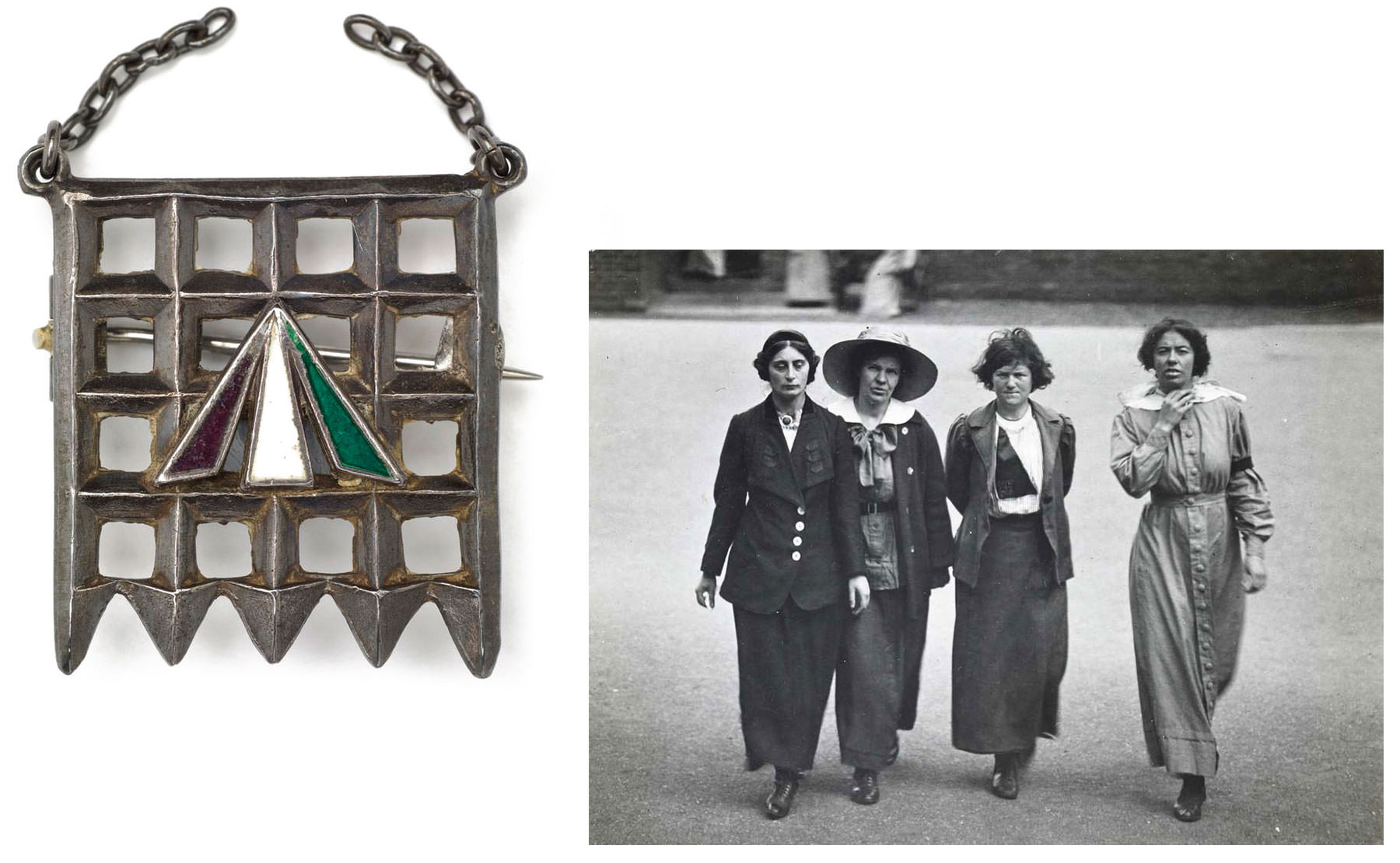
militaristic in appearance. The medallion took the form of a small silver roundel embossed with the name of the woman, and the words “HUNGER STRIKE”. Additional bars were added to the purple, white, and green ribbon for each period of force feeding the suffragette endured. Such medallions gave the suffragettes a visual strength and unity which amounted to a sense of political validation. The public practice of these honours offered the British Suffragettes diplomatic success at the London Congress of International Women’s Suffrage Alliance. With a healthy dose of theatricality, ex-prisoners were directed to file on stage to be presented with their honorary brooches and medallions in front of the crowd.
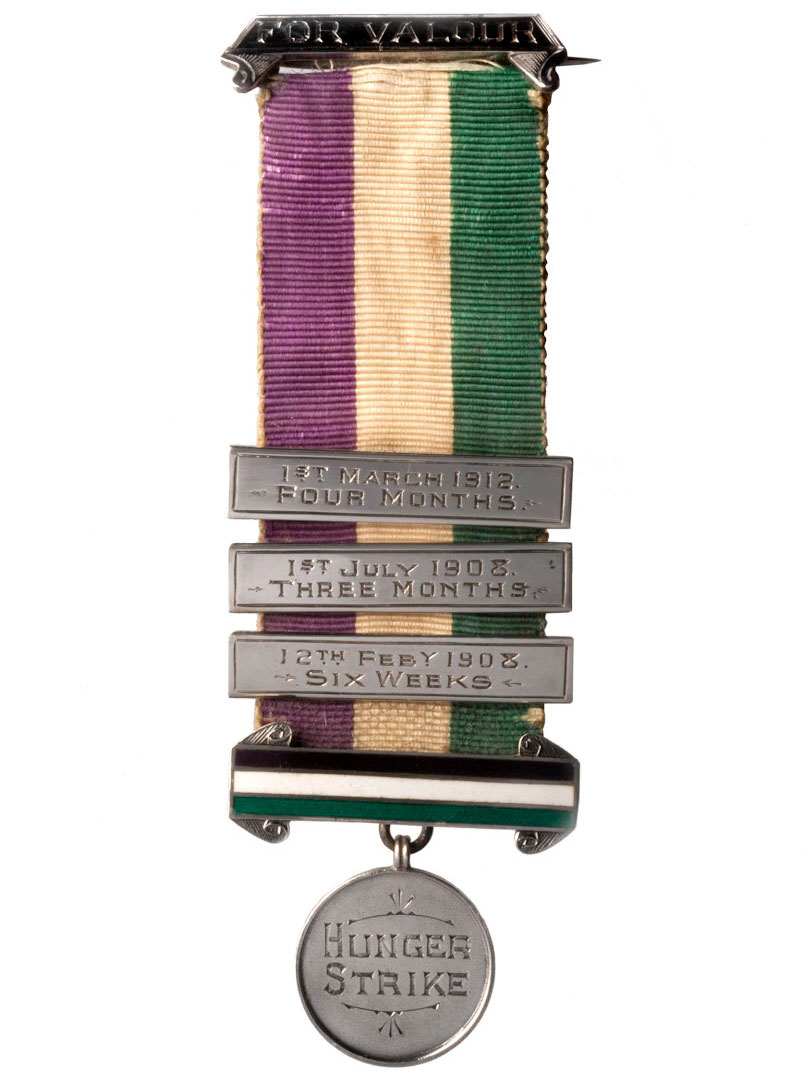
Later that week newspapers commented on the ‘virile’ organisation of the movement, according to Edwardian gender ideals. Such a comment, despite its reluctance, implied the movement’s strength and growing political veracity.
Saintly Suffragettes
The importance of the Holloway Brooch and Hunger Strike medallion only becomes clearer when analysing Suffragette portraiture. Nearly every depiction of a prominent suffragette features their material accolades in a nigh on attribute like fashion. Renaissance images utilised recognisable objects, attributes, in portraits of saints in order to make it clear who they were. Like St Margaret with her dragon or St Catherine with her wheel, Emmeline Pankhurst (Queen of the Suffragettes), Emily Davison, and Flora Drummond are all depicted with their Holloway Brooch and/or Hunger Strike Medallion. In each image their jewellery serves as a focal piece, a key identifier to inform the viewer that the picture and the poser have purpose.
Their symbolic importance is proven by the fact that newspapers of the day religiously recorded what suffragette jewellery looked like, and who was wearing it. Such records are greatly appreciated the historian. Many of these pieces seem to have disappeared into family jewellery boxes never to be seen againmaking it a rare opportunity to experience suffragette jewellery firsthand or in a public collection.
Scottish suffragette Flora Drummond’s portrait, commissioned in 1936 for the Forum Club (the first women’s members club) is perhaps the most characterful portrait of the bunch. An eccentric figure, legend has it that Drummond danced the highland fling outside Holloway prison to greet released suffragettes.
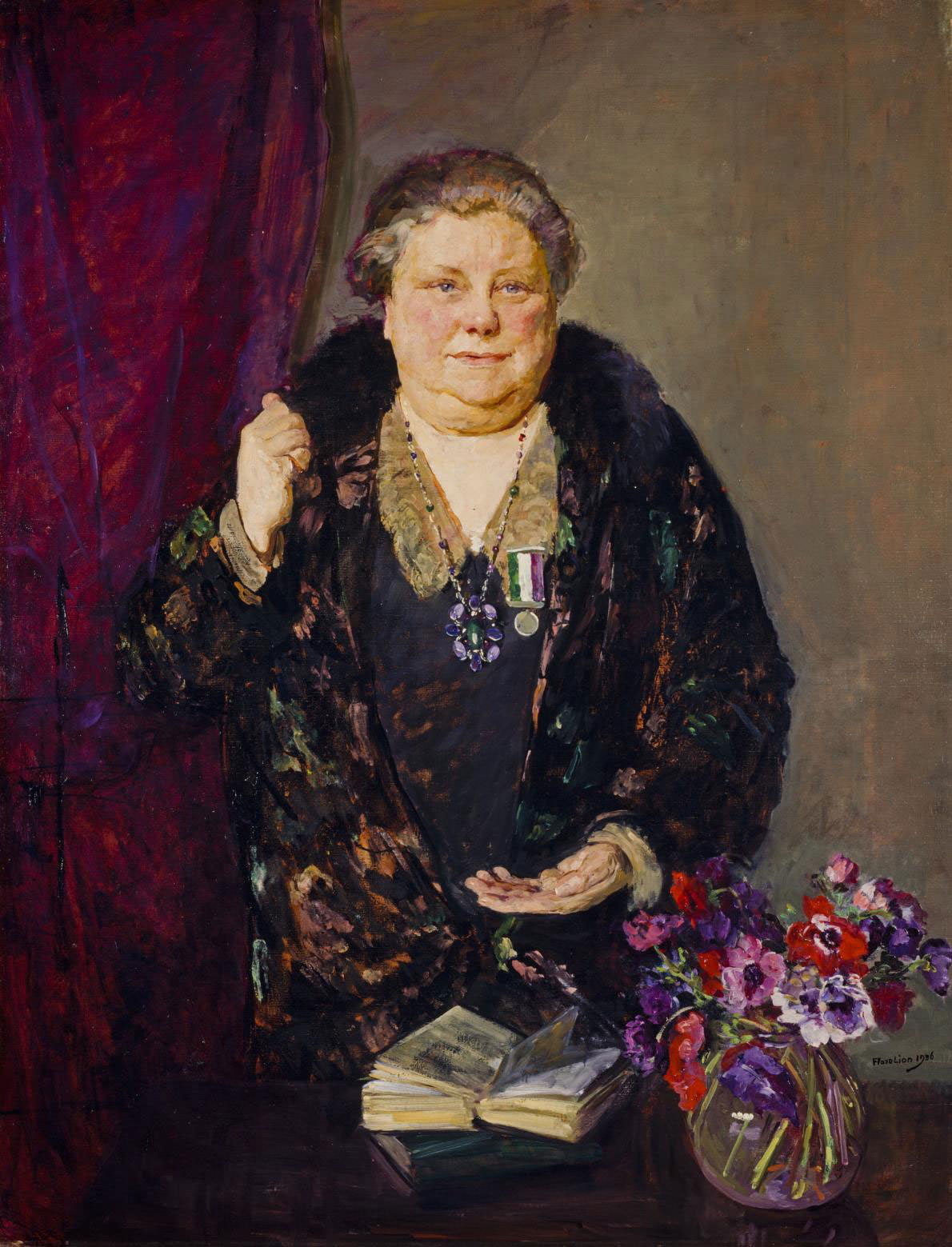
As interesting an image as that is to linger upon, the necklace that encircles her neck might be more interesting for what it divulges. Redolent of styles of the Art and Crafts movement (an artistic scheme that fought back against mass production in favour of artisanship) the piece speaks to the entrenched links between suffragism and the creative scene of late 19th century England.
Arts and Crafts and the Vote
Whilst commercially successful in the mainstream by 1908, suffragism owed its creative roots to a subversive bohemian world. Many women artists were active supporters of women’s suffrage, and 76 painters endorsed the cause in a list of supporters published in 1897. The founding of the Artists’ Suffrage League in 1907 encouraged women to organise collectively and contribute their specialist skills to the campaign explicitly. Sylvia Pankhurst herself had won a scholarship to the Royal College of Art, but gave up her studies to work for the WSPU. Emmeline too had ventured to open a shop in Hampstead stocking Arts and Crafts pieces with the specific aim to appeal to the housewife who should desire to have ‘inspiring things’ about her. It’s equivalent today might be one of those lifestyle shops in Notting Hill where you get nice candles, and fun napkins, and artsy silverware and…ahem.
Moreover, Christabel Pankhurst shared a close relationship with suffragette artist Ernestine Mills. In a black and white photograph which circulated the press of the age, she is depicted wearing a pendant bearing an uncanny resemblance to a Mill’s design now held in the Museum of London. Silver and heart shaped, it shows the enamelled winged figure of hope outside prisons doors, surrounded by suffragette colours. Whilst the Museum of London Pendant was created to specifically commemorate the release of Louise Mary Eates, it is more likely than not Mill’s made similar pieces for those comrades she held close. Although one may question the sincerity of mass produced suffrage jewellery, it is obvious that thought, care and earnestness still lay at the root of it’s design – serving a personal as well as public function.
From medallions, to fine rings, and pretty things it is overwhelmingly obvious that the Suffragettes knew how to market themselves. They knew when to stick to the rules of femininity and when to toe the line with masculine might. Whilst made commercially accessible through mass production, the movement’s nascency in bohemian circles remained an authentic part of the its identity. Raising these women to almost saintlike status in portraiture, let alone in reality, the jewellery of the suffragette movement acted as a signifier of duty, community and strength – perhaps absolving them of their ‘baser’ occupations …window smashing and the like.
You might also begin to ruminate upon capitalism’s role in furthering, or indeed hindering, political identities. Whether it does add credibility to the movement, or merely transforms it into a fashionable fad. Either way, I think it suitable to say Emmeline Pankhurst neglected a clause in her infamous speech “deeds not words”. Perhaps not words, but definitely deeds and decidedly jewellery.




 Free Shipping
Free Shipping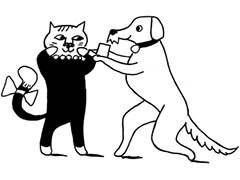 View All
View All
 Diamond Rings
Diamond Rings
 Sapphire Rings
Sapphire Rings
 Emerald Rings
Emerald Rings
 Ruby Rings
Ruby Rings
